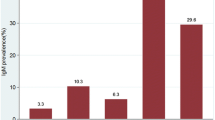Abstract
Many studies have been assigned to investigate the surveillance of congenital rubella syndrome, acquired rubella and seroprevalence in different countries to determine the new vaccination program and national vaccination schedules. Seroprevalence of rubella in Turkey is still insufficient and national immunization schedules do not include routine rubella vaccination. In this study we aimed to investigate the seroprevalence of rubella at child bearing age in an unvaccinated population in Adana, southern Turkey, to help determine whether routine rubella vaccination is necessary, if so when it should be administered. Ninety-four school girls aged 12–18 years living in Adana were selected for the study and stratified according to the socioeconomic status of their parents and evaluated for rubella antibodies. One hundred pregnant women aged 18–25 years and 100 pregnant women aged 26–35 years were sampled rubella antibodies. Rubella specific IgG antibody was measured qualitatively and quantitatively by using microparticule enzyme immune assay technology. Rubella specific IgG antibody was positive in 87–94 school girls (92.5%). The geometric mean rubella specific IgG antibody value was found be 148.14 IU/ml. No correlation was found between socioeconomic status and rubella seropositivity (p = 0.6521). In all pregnant women rubella specific IgG antibody was found to be positive. In conclusion rubella vaccination should be considered carefully in developing countries. Because of the high seropositivity to rubella in our region we do not recommend rubella vaccination in early childhood. Yet this is a preliminary study and further studies with larger population size are needed to determine the national immunization policy for rubella.
Similar content being viewed by others
References
Cutts RF, Robertson SE, Diaz-Ortega JL, Samuel R. Control of rubella syndrome (CRS) in developing countries, part 1: Burden of disease from CRS. Bull World Health Organ 1997; 75(1): 55–68.
Milosevic V, Jerant-Patic V, Mrda IE, Hrnjakovic-Cvjetkovic I. Acute rubella infection in women of reproductive age in Vojvodina 1994-1995. Med Pregl 1997; 50(3-4): 81–85.
Xiong XW, Diao LD, Yan Xl. Immune response of rubella vaccine in the population with different age groups. Chung Hua Liu, Hsing Ping Hsueh Tsa Chih 1997; 18(4): 227–229.
Cutts FT, Abebe A, Messele T, et al. Sero-epidemiology of rubella in the urban population of Addis Ababa, Ethiopia. Epidemiol Infect 2000; 124(3): 467–479.
Yadav S, Gupta S, Kumari S. Seroprevalence of rubella in women of reproductive age. Indian J Pathol Microbiol 1995; 38(2): 139–142.
Bustamante-calvillo ME, Damasio-Santana DL, Alvarez-Munoz MT, et al. Prevalence of rubella virus antibodies in pregnant women in two zones of Valle de Mexico. Ginecol Obstet Mex 1996; 64: 114–116.
Aksit S, Egemen A, Özacar T, et al. Rubella seroprevalence in an unvaccinated population in İzmir: recommendations for rubella vaccination in Turkey. Pediatr Infect Dis J 1999; 18: 5777.
Fogel A, Gerichter CB, Rannon L, et al. Serologic studies in 11,460 pregnant women during the 1972 rubella epidemic in Israel. Am J Epidemiol 1976; 103: 51–59.
Baxter DN. Control of the congenital rubella syndrome in Jamaica. West Indian Med J 1986; 35: 50–54.
Doraisingham S, Goh KT. The rubella immunity of women of child bearing age in Singapore. Ann Acad Med Singapore 1981; 10: 238–241.
Odelola HA. Rubella hemaglutinination-inhibiting antibodies in females of child bearing age in Western-Nygeria. J Hyg Epidemiol Microbiol Immunol 1978; 2: 190–194.
Robertson SE, Cutts RF, Diaz-Ortega JL, Samuel R. Control of rubella syndrome (CRS) in developing countries, part 1: Vaccination against rubella. Bull World Health Organ 1997; 75(1): 69–80.
Kendirli SG, Altıntaş DU, Alparslan N. Prevalance of childhood allergic diseases in Adana, Southern Turkey. Eur J Epidemiol 1998; 14/4: 347–350.
Ferrer Gomez C, Climent Duran M, Giner Almaraz S, et al. The prevalence of antibodies to the rubella virus in pregnant women at a health center. Aten Primeria 1999; 23(7): 429–433.
Kabiri M, Moatari A. The rubella immuno-surveilance of Iranian females: An indication of the emergence of rubella outbreak in Shiraz, Iran. Iranian J Med Sci 1993; 18: 134–137.
Expanded programme on immunization (EPI). Immunization schedules in the WHO eastern Mediterranean region, 1995. Wkly Epidemiol Rec 1996; 71(23): 173–176.
Makshseed M, Moussa MA, Ahmed MA, Abdulla N. The status of rubella immunity among pregnant women in Kuwait: Screening in child bearing age should be reintroduced. Acta Trop 2001; 78(1): 35–40.
De Azevado Neto RS, Silveira AS, Nokes DJ, et al. Rubella seroepidemiology in a non-immunized population of Sao Paulo State, Brazil. Epidemiol Infect 1994; 112: 579–594.
Jose MV, Olvera J, Serrano O. Epidemiology of rubella in Mexico. Salud Publica Mex 1992; 34: 318–327.
Rubella surveillance, United Kingdom. Wkly Epidemiol Rec 1993; 68(17): 119–120.
Anderson RM, May RM. Vaccination against rubella and measles: Quantitative investigation of different policies. J Hyg (Lond) 1983; 90: 259–325.
Cochi SL, Edmonds LE, Dyer K. Congenital rubella syndrome in United States, 1970-1985: on the verge of elimination. Am J Epidemiol 1989; 129: 349–361.
Lindegren ML, Fehrs LJ, Hadker SC, et al. Update: rubella and congenital rubella syndrome, 1980-1990. Epidemiol Rev 1991; 13: 341–348.
Author information
Authors and Affiliations
Rights and permissions
About this article
Cite this article
Karakoc, G.B., Altıntas, D.U., Kılınc, B. et al. Seroprevalence of rubella in school girls and pregnant women. Eur J Epidemiol 18, 81–84 (2003). https://doi.org/10.1023/A:1022538407514
Issue Date:
DOI: https://doi.org/10.1023/A:1022538407514




